Cornwall, for Brits, is a familiar sight on the small screen for Poldark and Doc Martin.
Aidan Turner steamily scything fields as the titular captain in the BBC period drama about 18th-century life there will not soon be forgotten by titillated Sunday teatime viewers.
Meanwhile, Martin Clunes as the eponymous GP, forced to give up city life to start practising in the fictional Cornish village of Portwenn, charmed ITV viewers for nearly 20 years.
The seaside county can also be seen as the windswept backdrop to 20th-century novelist Daphne du Maurier’s books, including Jamaica Inn and Rebecca.
Beyond the media, Cornwall has a rich history of smuggling and tin mining, and for many, a proud distinct identity, represented by its Cornish language and black-and-white flag.
And at the heart of its present is a thriving tourism industry – the retreat of summer holidayers and second home owners alike – which accounts for one in five jobs available in the county.
Combined with its stunning cliffs and beaches, its quaint cottages and cobbled, winding streets, its pasties and its insistence on jam before cream, the southerly tip of this sceptred isle is one of the jewels in Britain’s crown.
But little do many of us outside it know, there is a secret cog in the well-oiled machine that is its visitor economy: a British writer named Rosamunde Pilcher, beloved, of all nations, by Germany.
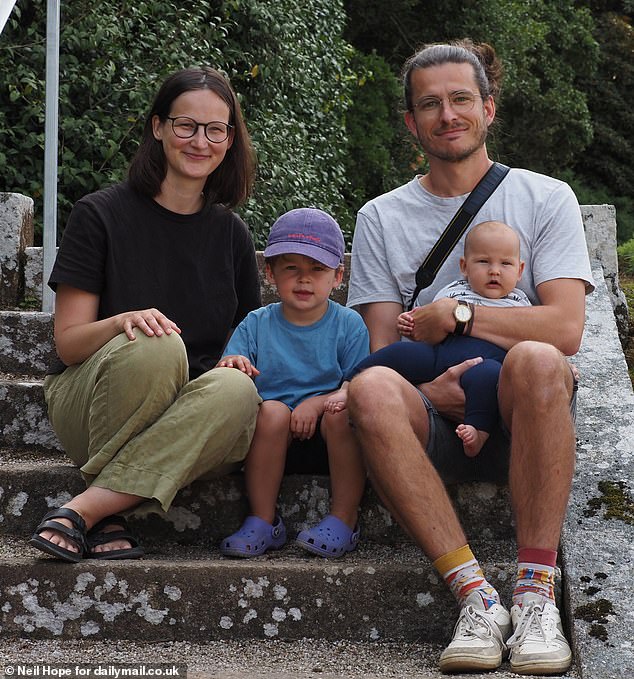
Around 350,000 German tourists visit Cornwall per year to catch a glimpse of the landscape that inspired Rosamunde Pilcher’s novels and the hit TV show. Pictured: Riccarda and Felix Griesshammer, 32 and 33, from Nuremberg, with Erich, three, and four-month-old Hedwig
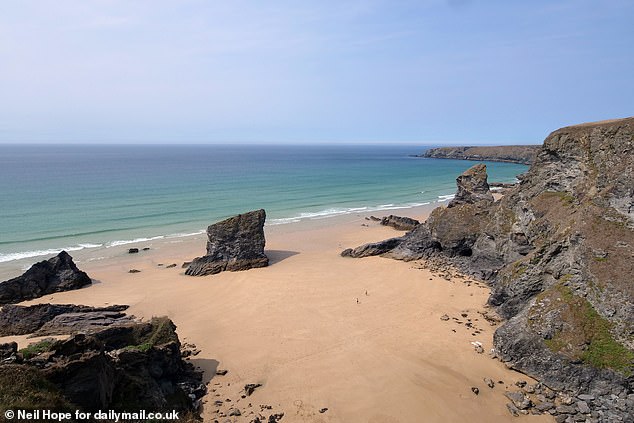
Pilcher was born in 1924, in the coastal village of Lelant, near St Ives, west Cornwall, but moved away after marrying a Scot, Graham Pilcher, 1951. Pictured: Bedruthan Steps, near Padstow, Cornwall
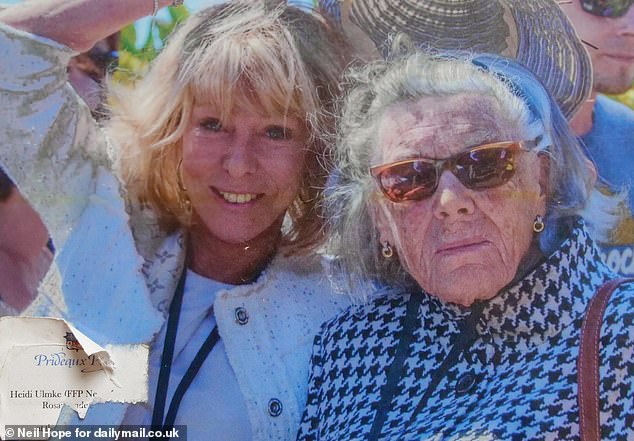
Inspired by her childhood home, Pilcher (pictured, right) began writing Cornwall-set romance novels, initially under the pseudonym Jane Fraser
Born in 1924, in the coastal village of Lelant, near St Ives, west Cornwall, she married a Scot, Graham Pilcher, in 1946, soon moving to his home country where she lived out her days, before sadly passing away in 2019, aged 94.
But she never lost her taste for home and, in 1951, began writing Cornwall-set romance novels, initially under the pseudonym Jane Fraser.
Pilcher was prolific until retiring in 2000 – she wrote 25 novels and eight short stories, novellas, collections and anthologies, all with the same Mills and Boon-esque plots.
But it was her 1987 book The Shell Seekers, written when she was 63, that made her a real star, selling more than ten million copies – and catching the attention of German broadcasters.
German film producer Michael Smeaton soon commissioned the first Pilcher film adaptation for his country’s national broadcaster ZDF, based on the 1975 novel The Day Of The Storm.
Sturmische Begegnung, which hit German screens in 1993, was watched by nearly nine million people. Needless to say, the channel quickly commissioned ten more.
Since then, a whopping 180 Pilcher adaptations – shot at various locations around Cornwall – have been made, charming German viewers at Sunday teatime while Brits watched Poldark.
Though set in the modern day, they present an upper-middle-class version of England, imagined abroad, that broadly does not exist anymore – one of tweed, shooting weekends and no computers or phones, always tied up with a happy ending.
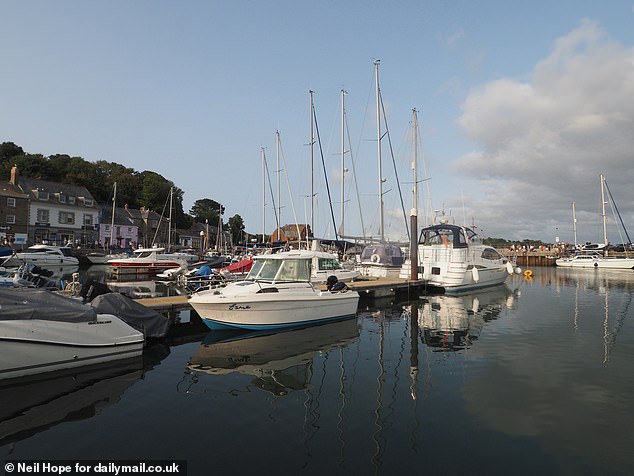
Over the years, 180 adaptations of Pilcher’s novels have been adapted – shot at various locations around Cornwall and becoming a mainstay of German TV. Pictured: Harbour in Padstow, Cornwall, which is a frequent Pilcher filming location
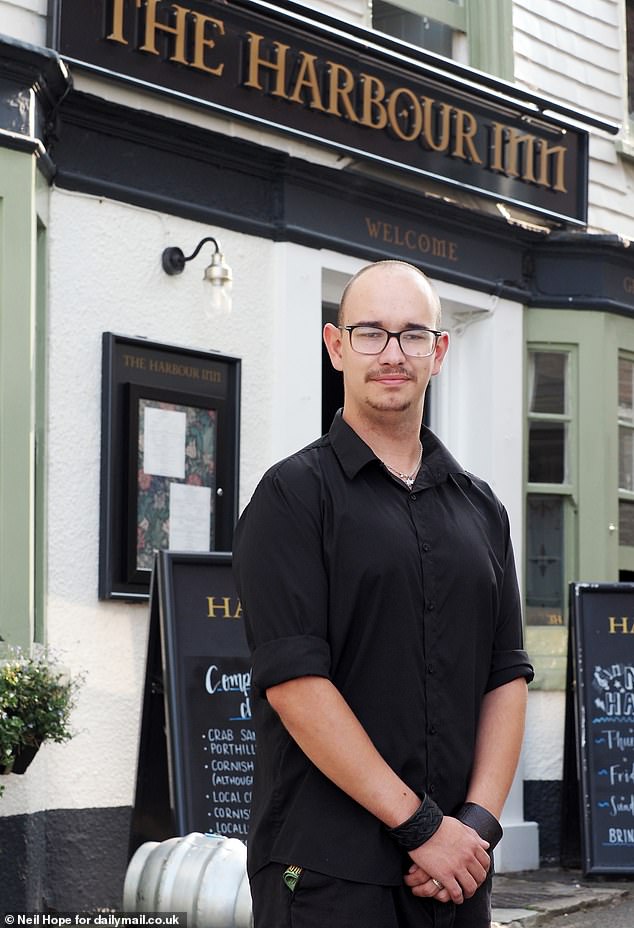
Alex Green (pictured), 21, assistant bar manager at the Harbour Inn in Padstow and a lifelong resident of the town said there are Pilcher shoots there every year, with some seeing the entire town square shut down for filming
This distinctive aesthetic is seemingly catnip to German viewers, who flock to Cornwall in six figure numbers each year to see where the magic happens.
Around 350,000 German tourists visit Cornwall per year, with two-thirds of all foreign visitors to the county from either Germany, Austria or Switzerland, the tourist board in harbour town Padstow said.
So, the Daily Mail headed south-west to find out what Pilcher – who won the British Tourism Award in 2002 for her film adaptations – was all about.
Riccarda and Felix Griesshammer, 32 and 33, from Nuremberg, were camping in Cornwall for three weeks with their children Erich, three, and four-month-old Hedwig.
They were visiting Pencarrow House, a beautiful stately home with gardens near Wadebridge – and used in several Pilcher films, most notably as a winery in 2011’s English Wine.
Mrs Griesshammer said, though the family was not just in the county for a Pilcher location tour: ‘We know about Cornwall because of Rosamunde Pilcher.
‘Germans, when they hear about Cornwall, they know it. There’s nothing you have to look up on the map, “Where is it?” You somehow know what to expect.’
Her husband agreed: ‘In Germany, when people think about Cornwall, they associate it with Rosamunde Pilcher.’
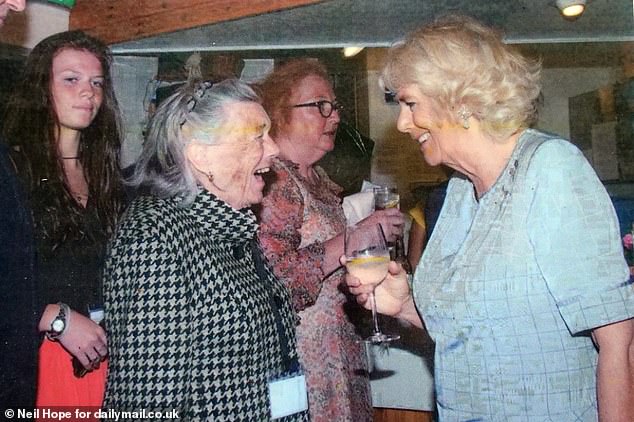
A picture of Pilcher meeting Queen Camilla
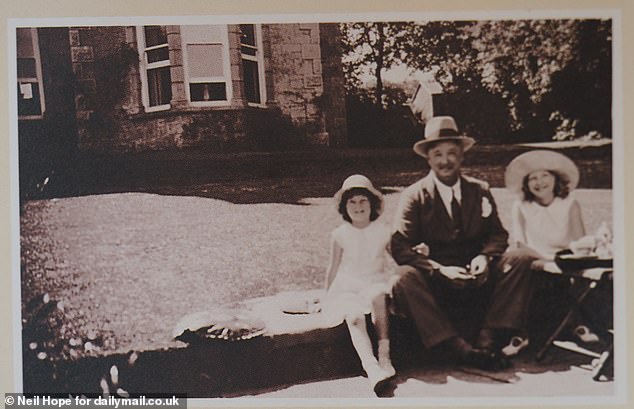
The childhood home of Pilcher (left) in Lelant, in 1928, with her father Charles Scott and sister Lalage

The filming locations, including Prideaux Place, are so popular with German tourists there are even German guidebooks (pictured)
The pair said Pilcher is most popular with their parents’ generation – Mr Griesshammer’s parents have previously visited Cornwall purely because of this connection: ‘My mother, she loves it.’
He explained the cheesy, schmaltzy appeal of the movies: ‘The films are not really good!’
Mrs Griesshammer expanded: ‘It’s not compared to Downton Abbey that has really a lot of historical background and stuff. And that’s not Rosamunde Pilcher at all.
‘I think it’s like disappearing into another world and imagining the English country life. And then you watch the movies and think everybody looks like this.’
Mr Griesshammer agreed it was down to ‘escapism’: ‘The storyline is very simple, it’s basic, it’s not really difficult topics – always love, nice landscapes.’
His wife, who said they would keep an eye out for more Pilcher locations in their guidebook, joked: ‘You could sleep for five minutes, wake up and then…’
Nearby Prideaux Place, a Grade I-listed Elizabethan country house sitting above the harbour town of Padstow, is also a popular destination for German, Pilcher-loving tourists.
The home of the Prideaux-Brune family for more than 425 years, the crenellated, ivy-covered manor, with 40 acres of land including a deer park, has been used in between 15 and 20 Pilcher films.
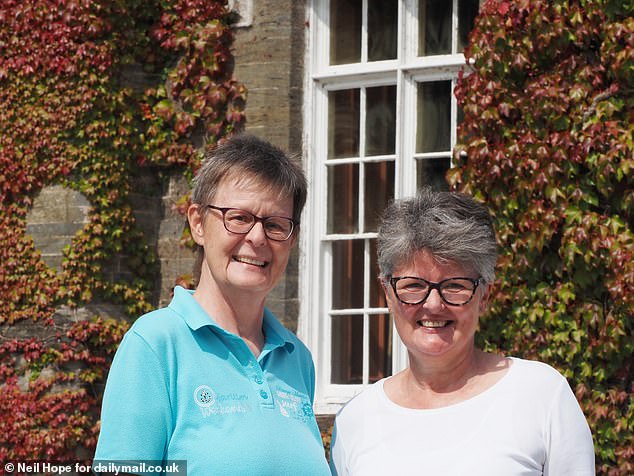
Visitors and friends Yvonne Fritz and Elizabeth Angliker (pictured) said that they were drawn to Cornwall because of Pilcher – revealing she is famous across the German-speaking world
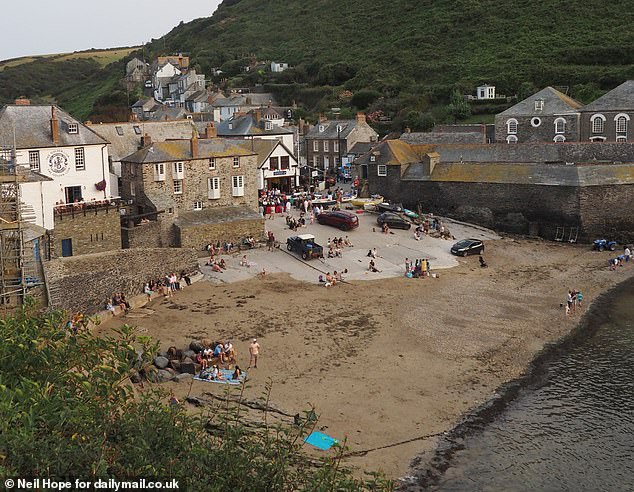
Pilcher’s books have made Cornwall so popular that Germans flock to the picturesque seaside area every year to take in the scenery. Pictured: Port Isaac, a frequent Pilcher filming location
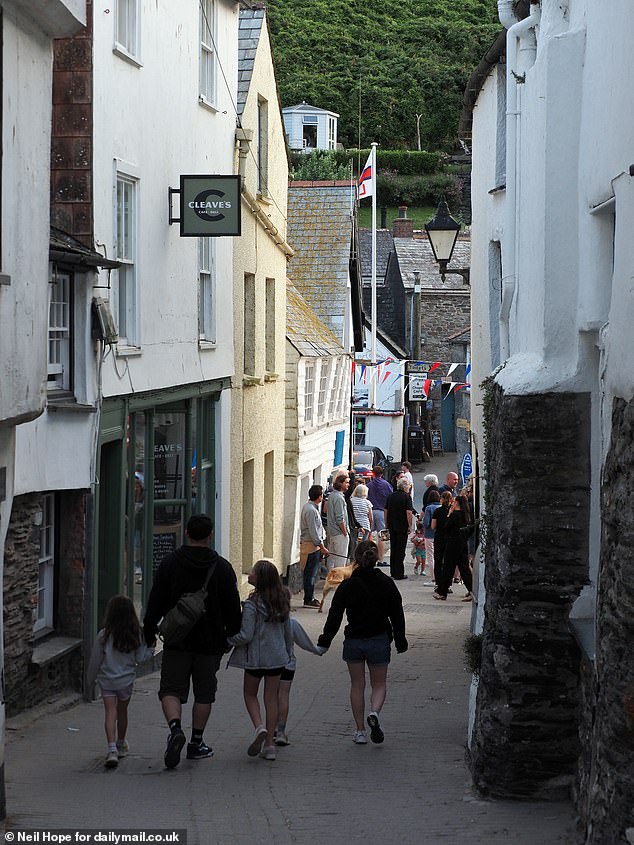
The area is full of German coach trips and German-speaking guides are often arranged to meet families travelling to the stunning coastline. Pictured: Port Isaac
The late Peter Prideaux-Brune, who sadly died recently, was a personal friend of Pilcher – who often visited the estate – and was incredibly proud of the connection.
And it features prominently in everything the house does – both German and English guidebooks are on offer, along with books on Pilcher and photos of her on display.
The estate has three to four German-speaking tour guides – the same number as those who speak English – and regularly receives large German coach trips.
Visitors and friends Yvonne Fritz and Elizabeth Angliker said Pilcher’s influence has even now spread across the German-speaking world.
They are from the German-speaking part of Switzerland, near Zurich, where they said Pilcher is also popular, along with Austria.
‘If you say, “Rosamunde Pilcher”, people say, “Cornwall”, and the opposite, if you say you travel to Cornwall, “Ah, Rosamunde Pilcher”. Everybody knows. It’s very famous’, Ms Fritz explained.
She laughed: ‘All the movies are running in the afternoon at four o’clock, people can watch them again and again. It’s always on TV.’
Speaking for them both, Ms Fritz said while she was keen to revisit Cornwall for the landscape and cliff walks after a great holiday there 20 years ago, Ms Angliker was there for Pilcher.
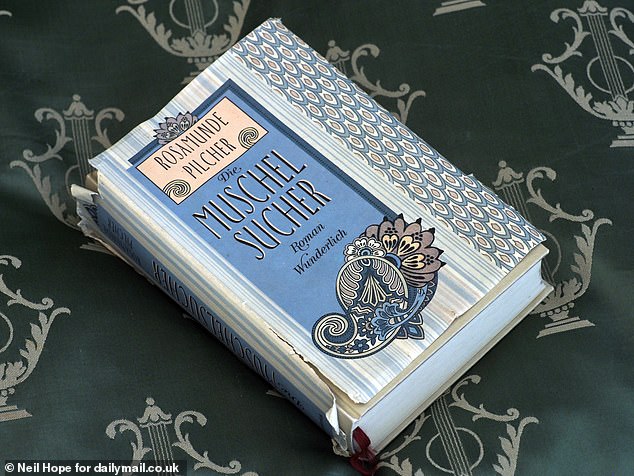
Pilcher was prolific in her writing until retiring in 2000 – she wrote 25 novels and eight short stories, novellas, collections and anthologies, all with the same Mills and Boon-esque plots. Pictured: A German-language version of The Shell Seekers
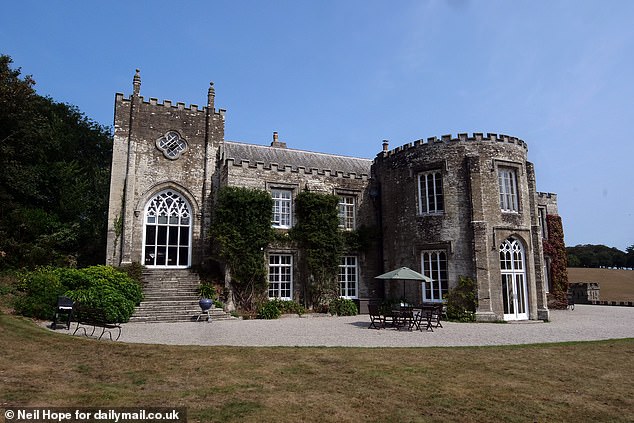
Prideaux Place (pictured), a Grade I-listed Elizabethan country house sitting above the harbour town of Padstow, is also a popular destination for German, Pilcher-loving tourists
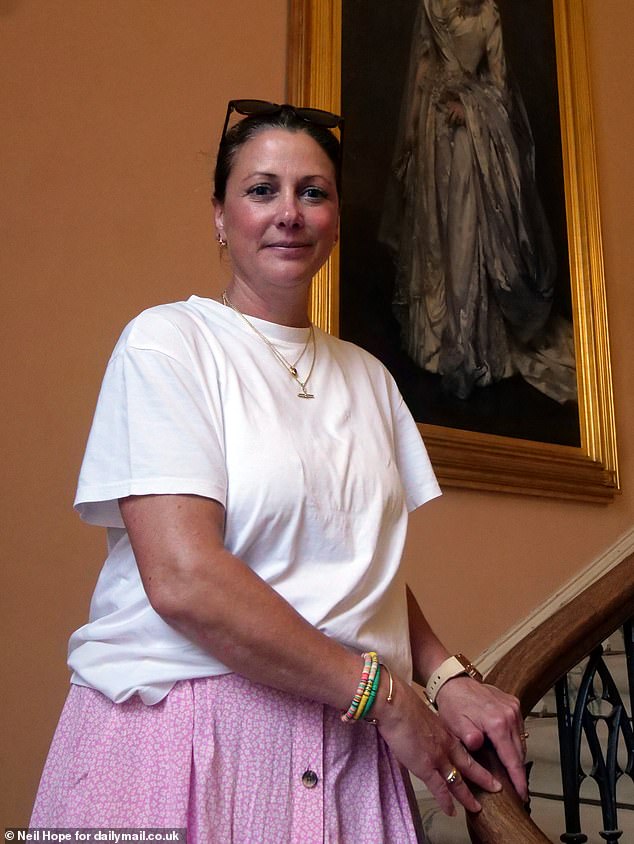
German-speaking tour guide at Prideaux Place, Myriam Stirling (pictured) revealed German tourists flock to the area because of what they’ve seen in the films
‘We were around and we saw, “Ah, Prideaux Place, we have to go there and we have to see this”, she said: ‘We really came here because of Rosamunde Pilcher.’
The pair, who had already been to another filming location, St Michael’s Mount, an island castle near Penzance, explained what German speakers love about the author.
‘It’s living in a nice residence like the earlier days. You have a lot of gardens, a lot of landscapes, beautiful area’, Ms Fritz said.
‘The lady sits on the cliff and is sad and they walk down to the nice village and it’s really Cornwall.
‘We don’t have buildings like this. We don’t have castles, we don’t have these landscapes, we don’t have these castle-type living houses and these families, we don’t have this in Switzerland.
‘We like this, we see the movie and then come here and see it.’
And on her Pilcher visit, Ms Fritz discovered a favourite Cornish TV show of the British, the books of which she was determined to find and read – but could not remember the name of.
‘Something with P?’, she began uncertainly, before a reminder: ‘Poldark. That’s why English people come here maybe.’
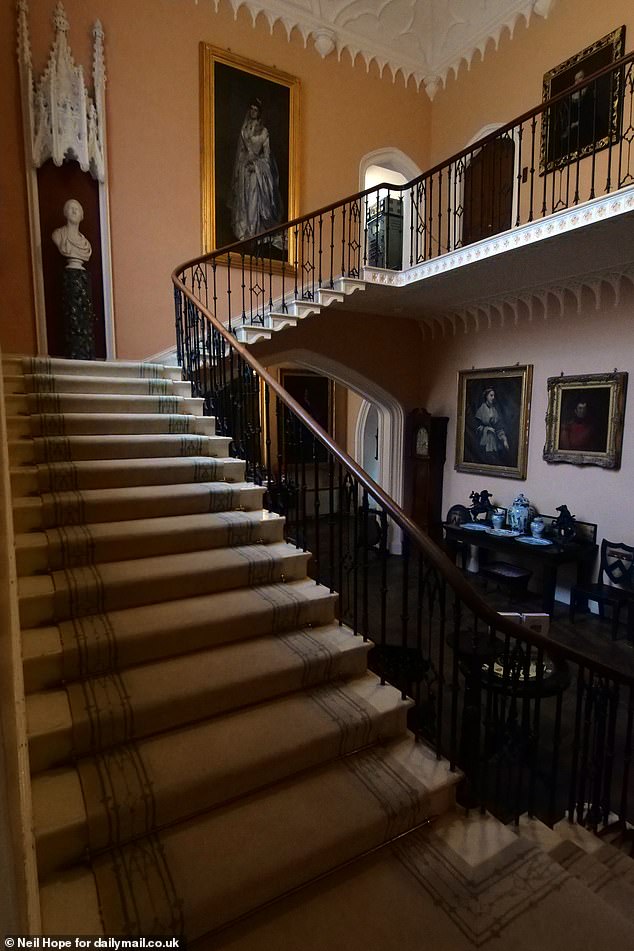
A particular favourite spot for German tourists is Prideaux Place’s sweeping cantilever staircase (pictured)
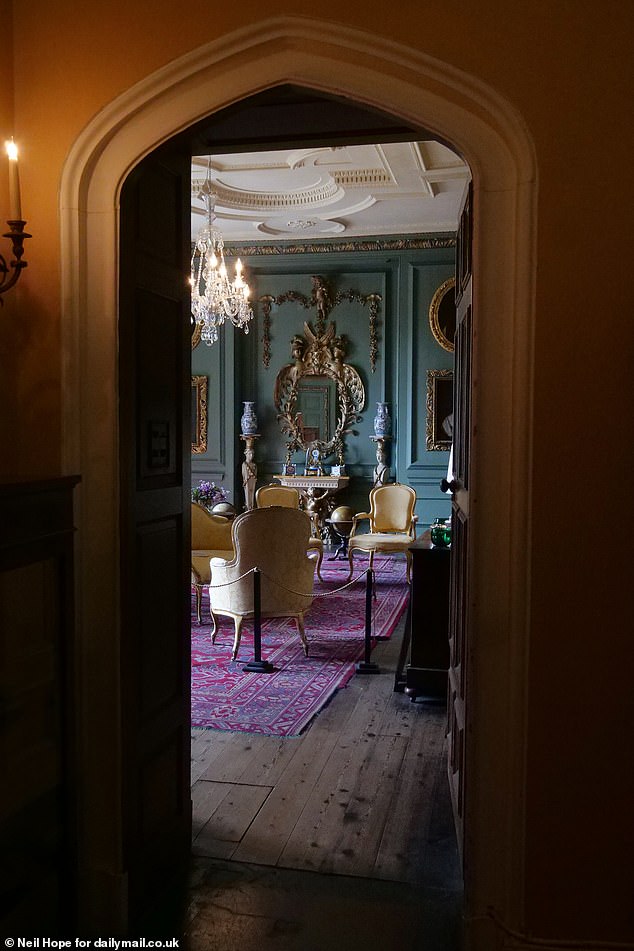
A grand panelled reception room, called the Grenville Room (pictured), often serves as a hotel bar or reception in the films and is sought out by tourists for a quick snap

Many of the sumptuously decorated rooms have appeared in the German TV adaptations. Pictured: Prideaux Place
The women’s German-speaking tour guide at Prideaux Place, Myriam Stirling, from Munich, has lived in Cornwall for years after marrying a Cornish man she met back home.
‘The Germans come here because they want to relive all of this because of what they see in the movies’, the guide of two years said.
‘It’s all very romantic, a bit cheesy, but it’s a very easy watch, you can iron while watching it.’
The films come out consistently every two or three years: ‘It’s a nice watch with your mum. It’s always a love story,you kind of know where it’s going.’
And as for Prideaux’s involvement, nearly every one of its 81 rooms is used for filming in any given shoot, with the house often serving as a hotel. The most recent shoot was only in spring.
A particular favourite spot of German tourists is the entry way’s sweeping cantilever staircase: ‘I call it the Rosamunde staircase because there’s usually a lady coming down with a drama and touching her face, “Oh, Marcus”‘
They also always recognise it as the site of one of the scarier moments in the Pilcher back catalogue – the sudden falling of a chandelier in one of her ghost stories.
A grand panelled reception room, called the Grenville Room, often serves as a hotel bar or reception – and the late Mr Prideaux-Brune starred in a recent Pilcher shoot there as a gin taster.
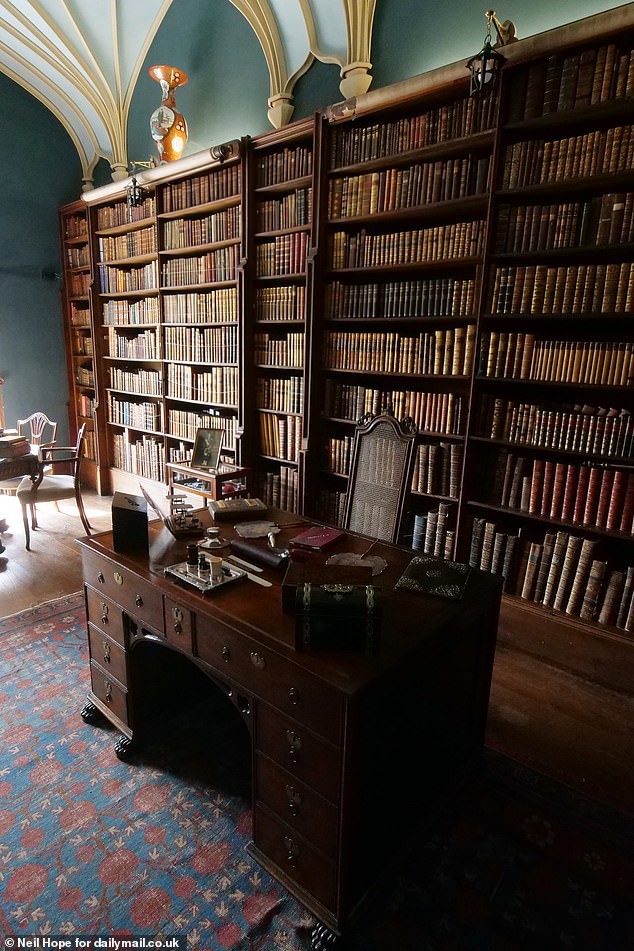
A grand library at Grade I-listed Elizabethan country house which forms part of the official tour for Pilcher-loving visitors
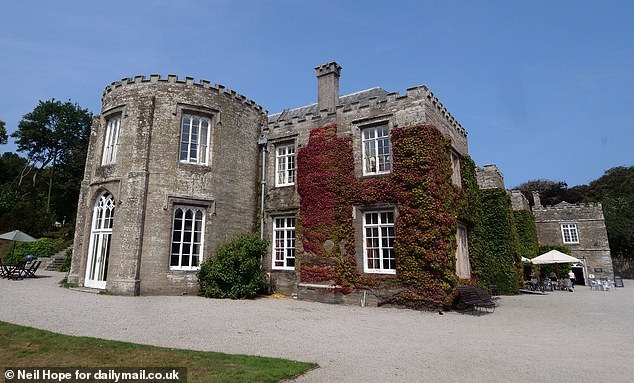
The crenellated, ivy-covered manor (pictured), with 40 acres of land including a deer park, has been used in between 15 and 20 Pilcher films
The Pilcher films are utterly beloved by the Germans Ms Stirling tours: ‘It’s just a picture of bliss. Of course, they make the sun shine all the time which we all know is not quite true.
‘But the sun shines always, there’s roses everywhere and people are called Marcus and they love all this, a little bit of cheesiness.’
They love to recognise shots at Prideaux, Port Isaac and Padstow alike: ‘They just want to reminisce the moments.’
And for Ms Stirling, too, it is a ‘sweet’ reminder of her late mother, who she used to watch the films with back in Germany.
She spoke fondly of the late Mr Prideaux-Brune: ‘Peter was always so proud that we have so many Germans coming and they still come, they come by coaches, masses of them.’
Meanwhile, back at Pencarrow, Gilly and James Molesworth-St Aubyn – part of the family that own and manage the Grade II-listed Georgian country house – told the Daily Mail of their experience hosting Pilcher shoots since 1998.
Mr Molesworth-St Aubyn said it is a delight to host German visitors while a shoot is happening: ‘They love it because they recognise all the people and they’ll recognise the actors and they recognise where various things were filmed.’
Mrs Molesworth-St Aubyn said it is amazing to see that distinctive romantic Pilcher aesthetic come to life in the estate’s 50 acres, with ‘amazing film prop flowers dripping out of the urns’.
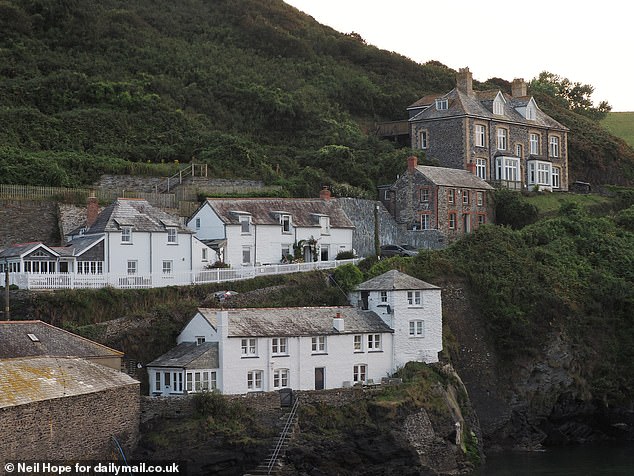
German visitors enjoy walking along the coastal path and visiting the beautiful buildings nestled in towns and villages along the way. Pictured: Port Isaac
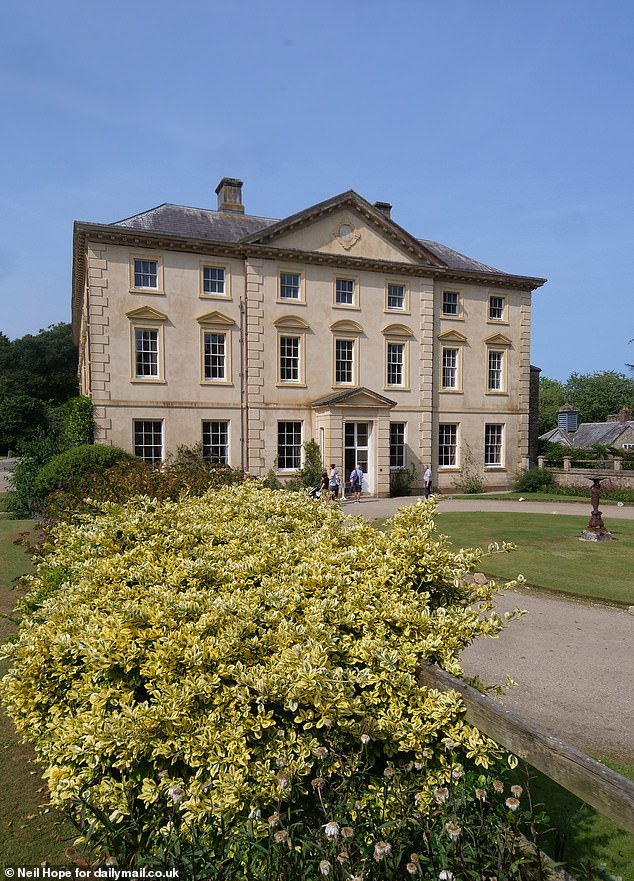
Pencarrow House (pictured), a beautiful stately home with gardens near Wadebridge – and used in several Pilcher films – is also a popular tourist spot

Mr and Mrs Griesshammer (pictured) said they loved visiting because it was like ‘disappearing into another world and imagining English country life’
Her husband said these are so gorgeous: ‘We do quite often ask them if they’re happy to leave them behind because they look really good.’
And it has always been a fun addition to family life, Mrs Molesworth-St Aubyn said: ‘I think one of the best parts about the filming was their catering van.
‘My children went to our local school and every morning, when they walked down to the bus stop, they had this bus that was that was parked there that had wonderful bacon and egg rolls.
‘And they’d always make my kids a bacon and egg roll on the way to the bus stop. And everyone enjoyed that a lot.’
Mr Molesworth-St Aubyn explained what makes Pilcher movies so good: ‘In all the films, it’s gloriously sunny.
‘The weather is always really good – it doesn’t matter if you’re inside, you’ve got the sun coming through the windows.
‘It gives a very romanticised sort of view of Cornwall and Pencarrow which is sort of harking back to the olden days.’
Mrs Molesworth-St Aubyn agreed: ‘AGA saga. Romantic, soft focus, gentle family dramas. It’s a winning formula.’

James Molesworth-St Aubyn (pictured) – part of the family that own and manage the Grade II-listed Georgian Pencarrow House – said the property has been hosting film shoots since 1998
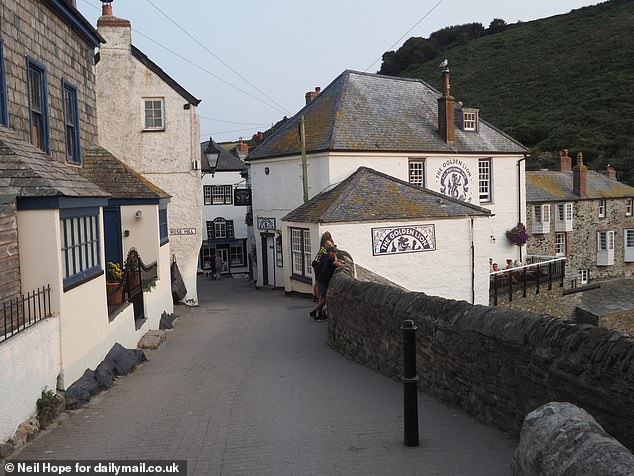
Cornwall has been made famous by other TV shows including Doc Martin – but none have had the impact overseas that Pilcher’s novels and TV adaptations have had. Pictured: Port Isaac
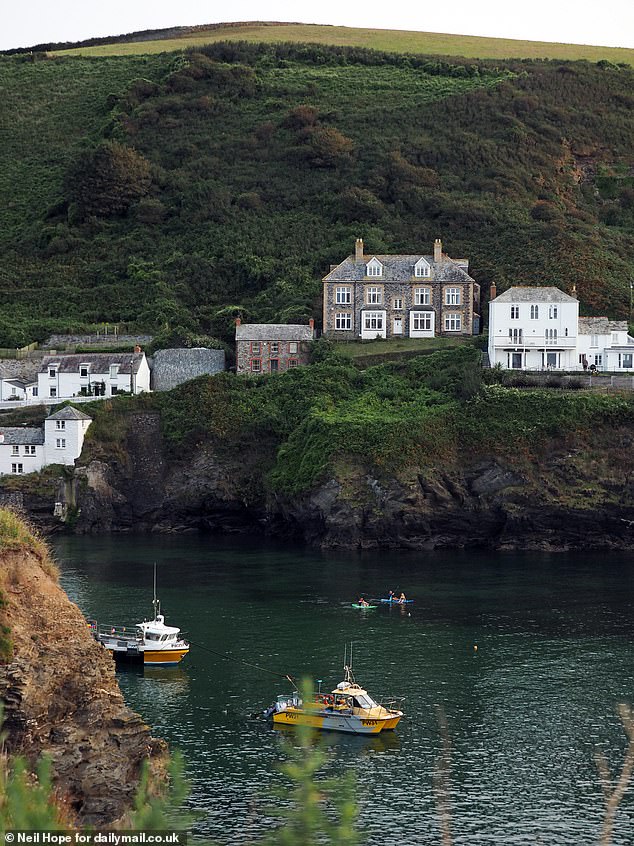
Steve Dawes, a tour guide of nearly ten years, said he is seeing more Germans on holiday in Cornwall and flocking to areas made famous by TV shows including Doc Martin and Poldark. Pictured: Port Isaac, where Doc Martin was filmed
And she added there is a kind of timelessness to them: ‘She didn’t write about smartphones. No one’s texting anyone.’
Like Prideaux, Pencarrow often receives German coach trips and a German-speaking guide is often arranged to meet them, with a German-language recording available as a back-up.
And in recent years, she said, ‘We’ve definitely seen more Germans, for sure’, with her husband adding: ‘Obviously, with a pandemic, that cut right back, but we’re now getting back to pre-pandemic numbers, if not more.’
Mrs Molesworth-St Aubyn reflected Pilcher’s legacy will likely ‘go on for years’: ‘She did a good job of tapping into what makes Cornwall wonderful and I think that really comes across and is timeless.’
The huge numbers of Germans flocking to Cornwall every year are testament to the power of so-called ‘screen tourism’.
Some 70 per cent of visitors to the UK on a leisure trip in the last ten years have seen a film or TV location in their time here, VisitBritain research from 2023 showed.
And a huge ninety per cent of potential visitors to this country would be interested in visiting this kind of tourist site.
It may well be the balm to ease Cornwall’s wounds, after it has recorded an overall decline in tourism in the last few years.
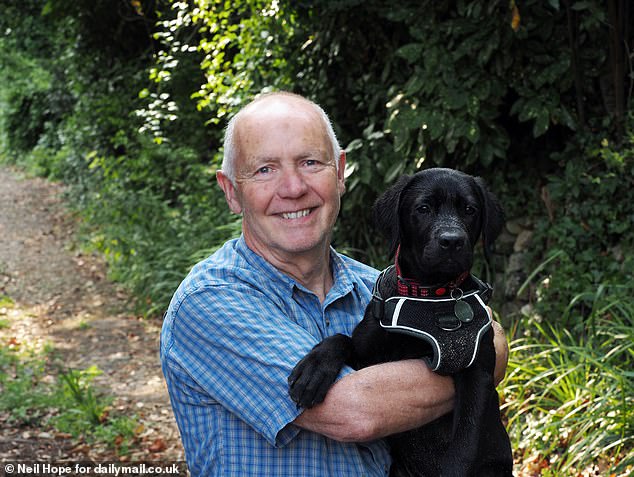
John Hewitt, 67, (pictured) an architect from Lelant, said he has often seen Germans visiting Pilcher’s birthplace
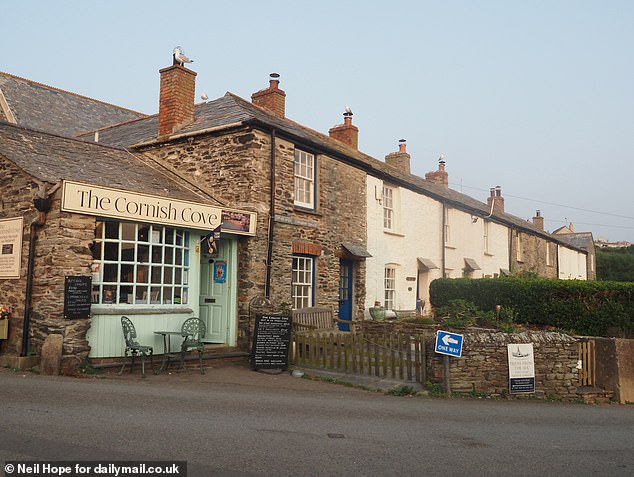
Locals say they are always surprised by the ‘little niche group of people’ that come because of Pilcher and expect people to come for Rick Stein’s restaurant or to see the filming locations of UK TV shows. Pictured: Port Isaac
A record five million visitors descended on the county in 2022 – but this was down by around ten to 15 per cent in 2023 and declined by a further ten per cent in provisional data for 2024.
And across the county, locals have broadly received German-speaking Pilcher tourists with open arms.
In Lelant – a frequent Pilcher filming location and where she was born, in a grand sea-view house which is now a B&B – John Hewitt, 67, said he has often seen Germans visiting it as Pilcher’s birthplace.
The local and architect said it is a real mix of demographics, often with dogs: ‘They always seem to enjoy it, I often speak to them and they enjoy coming. They’re over the moon with it, actually.’
They frequently mention the Pilcher connection: ‘They seem to like the landscape and they find Cornwall very friendly, they tell me quite often.’
He explained what he thought the draw is: ‘It’s quite different to the developed German cities.’
Compared to a landlocked city like Dortmund, for example, he said: ‘The fresh air, the quality of the light and the openness of the estuary, the colour of the sea.
‘Those sorts of things they enjoy, that draws them here and then, once they’ve found it, they keep coming back.’
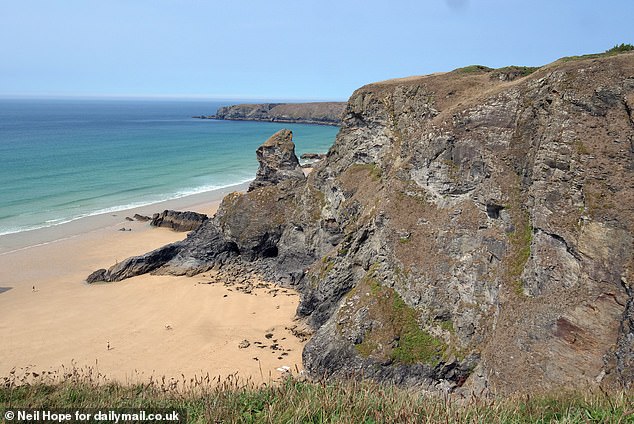
Locals say there are two main reasons Germans come to Cornwall – the coastal paths and to see the setting of Pilcher’s famous books. Pictured: Bedruthan Steps, near Padstow, Cornwall
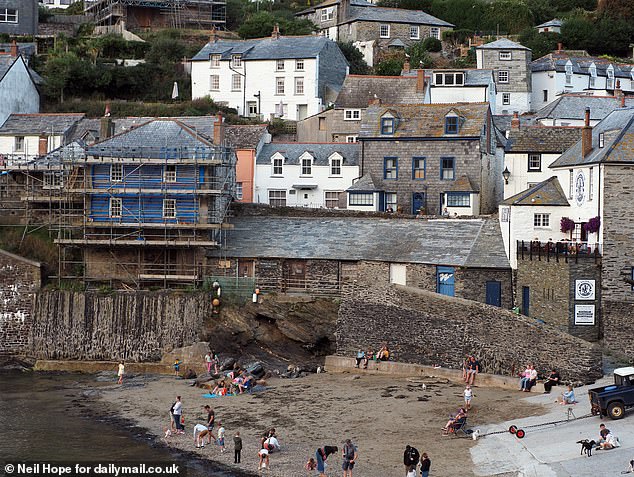
Lifelong Port Isaac (pictured) residents are worried that too much exposure through films and TV shows will result in more locals being displaced due to rising house prices
Mr Hewitt has not personally seen Pilcher filming in Lelant but he has in nearby town St Ives: ‘They do come and do a pilgrimage on the subject, I’m sure they do.’
He loves their attraction to Cornwall and thinks their relationship with locals is very ‘harmonious’ – and has contributed positively to the county’s tourism industry.
‘The combination of location and storyline, I suppose it’s like [BBC eighties crime series] Bergerac, the success of that, what that did for Jersey’, he explained.
Meanwhile, in Padstow, with Prideaux Place perched on the hill above, assistant bar manager Alex Green, 21, has also often encountered Germans there to learn about Pilcher.
‘I get people from all over the world but I do get a lot of Germans’, he said – and they frequently mention the author when he asks why they have come to the town, which was his first introduction to her.
The worker at the waterfront Harbour Inn and lifelong Padstow resident said there are Pilcher shoots in the town every year, with some seeing the entire town square shut down for filming.
‘They were meant to film in [the pub] for a scene but they ended up going up to Prideaux Place’, he said.
Mr Green explained Pilcher is one of two main reasons Germans come to Cornwall: ‘A lot of Germans go on the coastal path walk so they come over to the UK for three, four weeks, they go up London way and then they come down here.
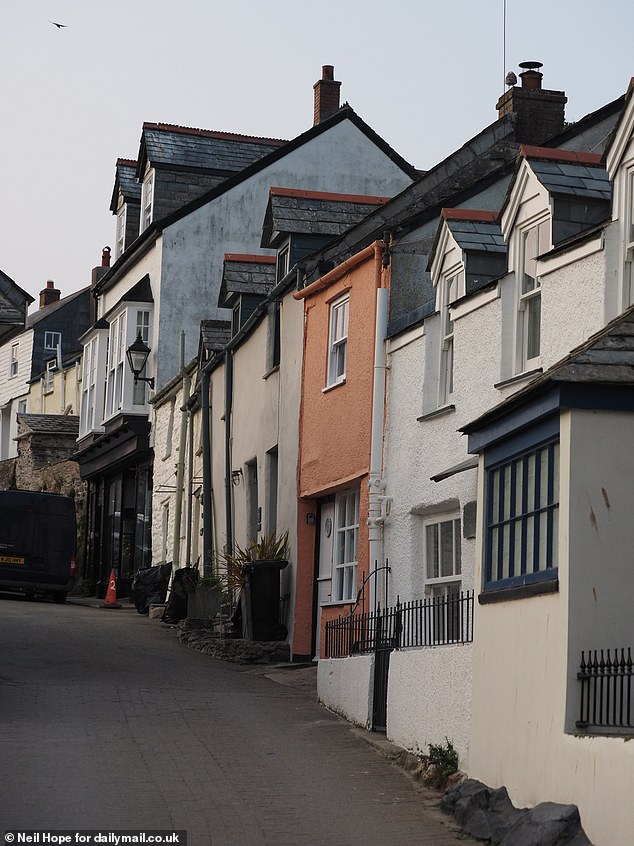
Locals say shoots in the village (pictured) for Pilcher films, Doc Martin and the Fisherman’s Friends band ‘just get in the way’
‘Since working here, I’ve met so many Germans, all coming for the same reason, go and walk, come and see where it’s been filmed.’
But she is often a secret from Cornish people themselves: ‘Probably most of the people don’t know about it because you’ve got [Rick] Stein’s [restaurants] that would overshadow it and things like that. So, it’s just a little niche group of people that come to see that.’
Pasty shop catering assistant Debbie Holland, 42, said she had served some German tourists just before speaking to the Daily Mail.
She said it is consistently the most common nationality of foreign tourists she serves: ‘Especially this year.
‘I’ve seen the Italians, but a lot, a lot of Germans, more Germans than I’ve served before I think.’
Ms Holland, who said Pilcher’s name rings a bell, explained: ‘I think it’s because the name of the author has become quite popular.
‘It sounds like there’s a trend so obviously people jump on the bandwagon then obviously, Cornwall is beautiful anyway so they will see it and think, ‘Oh, I want to go there’.’
They often come on large coach trips or in groups of at least 20 people, she said: ‘But they are very friendly, very, very friendly. I don’t think I’ve ever met a rude German person.’
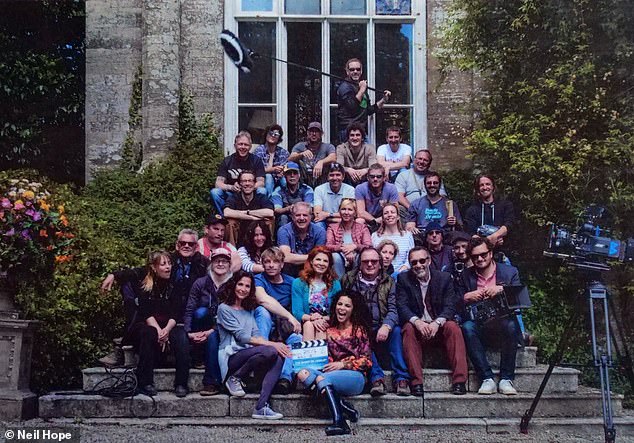
The area is given over to filming for long periods of time but none of the locals seem to mind. Pictured: A German TV production team at Prideaux Place
Though over in nearby Port Isaac, one lifelong resident of the fishing village – who wished to be known simply as Max P, for fear of local repercussions – was feeling less happy.
The pub worker spoke with praise about German tourists, some of whom have told her they are there specifically for Pilcher – Port Isaac was used as a filming location for The Shell Seekers.
‘We get a lot of Germans in, Super nice people’, the young woman said.
Visitors, especially Americans, she said, are also attracted to the village as the filming location of Doc Martin, which is filmed in the US.
They also know it as the home of Fisherman’s Friends, a famous folk group of local seafarers who released a top ten album of sea shanties and were the subject of a 2019 biopic featuring David Hayman.
But all this ‘overmediatisation’, Max P said, is ‘super just drawing people in’ to buy property and live there.
This is difficult for lifelong Port Isaac residents like her family, who were forced out of the village when she was 15 because they could no longer afford to live there.
‘Obviously, I understand – gorgeous village. I love where I’m from – absolutely standard’, she said.
‘But it’s just so overspent and it’s everywhere online and it’s just so overdone to the point where we’re no longer able to have our traditions and have our families in the village that we were meant to be raised in. It’s super upsetting.’
She got emotional when adding: ‘My family has worked here for generations. This is where my mum and my dad met.’
Max P added: ‘It’s ruining the entire village. I think there’s something like five people that live permanently down in the village that actually own their own homes at the moment…
The young woman has seen shoots happening in the village for Pilcher films, Doc Martin and the Fisherman’s Friends band: ‘It just gets in the way.
‘It just feels like they’re trying to media-ise people trying to just work and live through their daily life.’
Steve Dawes, a tour guide of nearly ten years, said he is seeing more and more Germans on holiday in Cornwall, likely up there with the Americans as the most common nationality of foreign tourists.
‘They talk about Rosamunde Pilcher quite a lot’, he said, explaining its visual appeal to a landlocked nation – and its harking back to a bygone age.
‘The scenery, they don’t have in Germany… I would say it’s the sea that brings people here because we’re surrounded by the sea on all three sides’, he said.
‘People’s belief of the English is Downton Abbey – that sort of hundred years ago society.’
And keeping people coming to Cornwall is vital, he said: ‘Towns like Newquay, Padstow and St Ives would never have survived without Victorian tourists coming here 200 years ago on the railway line and they’ve been coming here ever since.
‘The old trades that did provide Cornwall with its income, fishing, farming and mining, they’re still very, very important, but they’re much, much smaller than they were, and so Cornwall really does rely on tourism.’
It is the present and future of the county at large – and the potent alchemy of Pilcher in particular is undeniable: ‘They seem to love her, simple as that.’











